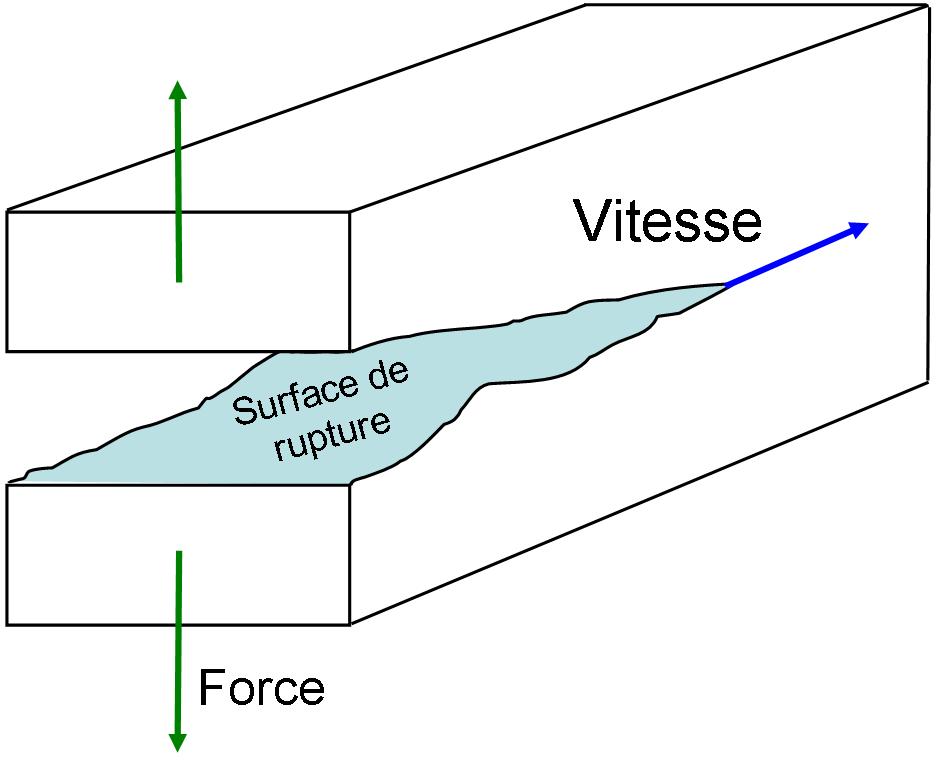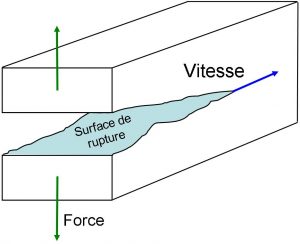J. Scheibert, C. Guerra, F. Célarié, D. Dalmas and D. Bonamy
Depending on their fracture mode, materials are traditionally gathered into three distinct classes:
- (i) ductile materials that like metals deform plastically before their fracture
- (ii) quasi-brittle materials such as rock or concrete, where “non-visible” damage starts to accumulate through microcracking, up to coalescence that yields to catastrophic failure.
- (iii) brittle materials like oxide or polymer glasses… that deform elastically up to their fracture. This occurs through the successive breaking of atomic bonds at the crack tip.
Experiments performed at IRAMIS-SPCSI show that a given material may, depending on the crack velocity, belong to two of these categories: Plexiglas®, archetype of brittle material, is found to damage through the nucleation of microcracks like quasi-brittle materials, beyond a well defined crack speed.
Crack propagation is the basic mechanism responsible for the catastrophic failure of brittle materials (e.g. a broken glass). To explain the phenomenon, the challenge is to find the relationship between the applied opening “force” applied to a crack and the velocity of its front. This relationship necessarily involves a third quantity, so-called the fracture energy, which is the energy cost to increase the fracture surface over a unit area. In brittle materials, the fracture energy remains constant during the propagation of the crack. It can then be predicted that the limiting crack speed is equal to the Rayleigh velocity (the speed of an acoustic wave along the surface). On the other hand, a large number of experiments contradict this prediction. Explanation of this discrepancy is presently a very hot debate in fracture mechanics.
To understand the origin of this disagreement, an experimental setup has been developed through collaboration between SPCSI and UMR CNRS/Saint-Gobain to study the failure mechanisms in a model brittle material – Plexiglas® – over a broad range of velocity. For low crack speeds, the fracture energy remains effectively constant and the material remains perfectly brittle. But at a given speed threshold (165 m/s) the energy triples abruptly. Simultaneously, the fracture surfaces become ornamented with conical marks. Beyond this onset, both the energy of fracture and the mark density increase with crack speed. The energy diverges when the velocity approaches a value of the order of one half the Rayleigh velocity – those hence being unreachable.


Similar conic marks were observed on a large number of materials. They are generally interpreted as the signature of the formation of penny shape microcracks ahead of the main front that broaden with time. When these microcracks coalesce with the main crack front, they left these characteristic conic marks on the fracture surfaces. Beyond the threshold of 165 m/s, the failure of Plexiglas® is therefore accompanied by damage, like a quasi-brittle material. A simple model allow then to capture the variations of the fracture energy with crack velocity, and hence to explain the speed limit.
Some arguments suggest that the transition between the dynamic “brittle” behavior to the “quasi-brittle” one observed on Plexiglas, can be generic and applicable to a wide range of materials. New experiments are currently designed to check this conjecture.

Reference:
|
Brittle-quasibrittle transition in dynamic fracture: an energetic signature J. Scheibert, C. Guerra, F. Célarié, D. Dalmas, and D. Bonamy Phys. Rev. Lett. 104 (2010) 045501 |
|
| Physical Review Focus |
Contact: Daniel Bonamy (CEA-IRAMIS/SPCSI) and Davy Dalmas (UMR CNRS-St Gobain).




